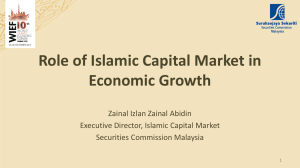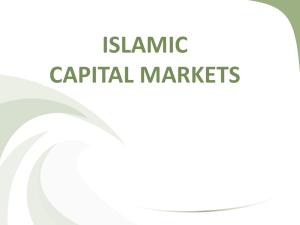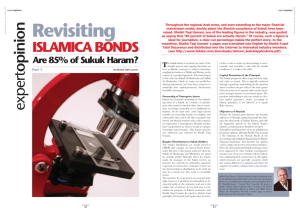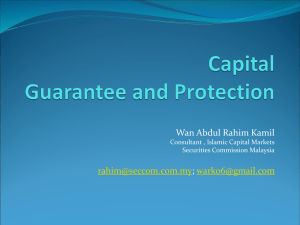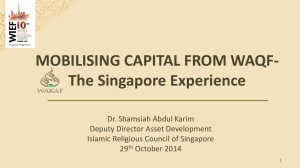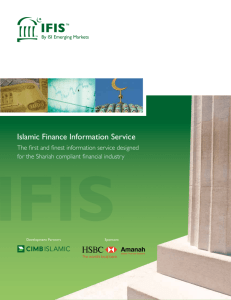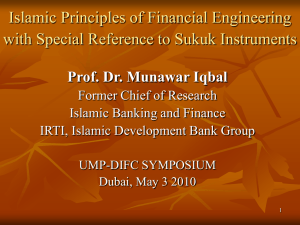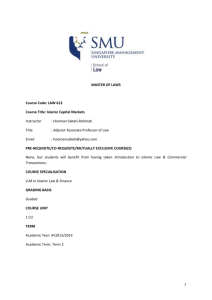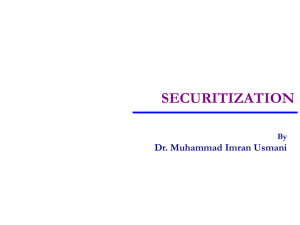Securitization and Sukuk - AlHuda Centre of Islamic Banking
advertisement
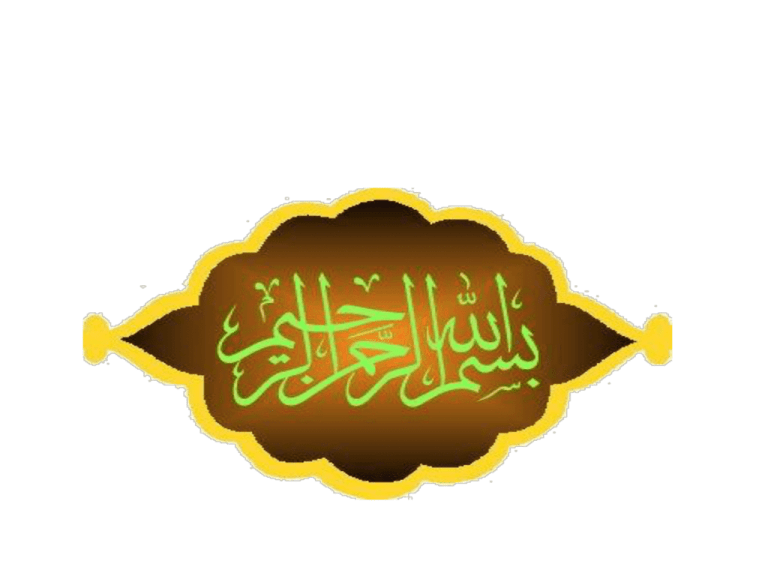
Securitization and Sukuk By Muhammad Ayub Key Components: Islamic Capital Market • Shariah Compliant Stocks • Islamic Funds • Sukuk / Islamic Investment certificatesFixed, quasi fixed and Variable return securities Shariah Compliant Stocks • Shariah Guide lines: • Shariah based principle of equity participation is Shirkah • Stocks are classified as Shariah compliant if their business activities do not fall in the prohibited list prescribed by Shariah Scholars • Certain financial ratios are also applied for screening. Shariah Compliant Stocks Prohibited activities: • Alcohol • Gambling • Pork related products • Pornography • Conventional financial services • Conventional insurance • Tobacco, • Indecent Entertainment Financial Ratios: • Main ratios applied are – Debt to equity ratio – Cash and interest bearing securities to equity ratio – Cash to asset ratio • In Malaysia, the screening of listed stocks is undertaken by a centralised body- Shariah Advisory Council of SEC • In other jurisdictions, screening services are performed by individual institutions Shariah Related Issues in Stocks Trading • Not permitted to purchase shares by raising interest bearing loans through a broker or someone else. • Not permitted to pledge the shares for the interest bearing loan. • It is not permitted to sell the shares that the seller does not own which is called short sale. The promise by the broker to lend these shares at the time of delivery is of no consequence. Issues in Stocks Trading (Contd) • Not permitted to conclude futures contract for shares because according to Shariah only one thing either payment or delivery can be deferred. • The contract of Salam is not permissible in shares – identified items. Sukuk • Sukuk refer to securitization, a process in which ownership of the underlying assets is transferred to a large number of investors. • Different in nature from Stocks of companies. These are certificates of equal redeemable value representing undivided share in ownership of tangible assets of particular projects or specific investment activity, usufruct and services. • Details about types of Sukuk as suggested by AAOIFI Shariah Bases of Sukuk Issue • Equity Based: Essentials of Musharakah and Mudarabah; • Salam based – salam Rules • Ijarah based – Rules of Ijarah • Murabaha based ? No / Yes • Mixed portfolio Sukuk – Ratio of cash and receivables? Securitization Involves: • Evaluating specific risks • Isolating and efficiently allocating risks • Evaluating the taxation, accounting and legal implications within the regulatory framework • Designing appropriate credit enhancement structures e.g. over collateral, cash collateral, subordination etc. • Pricing the residual risk. Securitization: Unbundling of roles Traditional business model revolves around originating an asset and holding it till maturity Through securitization, it is possible to Disaggregate, repackage and distribute assets to different parties – able and willing to accept them Realize benefits from specialization and economies of scale • Securitization transforms originator’s role from being an accumulator to that of a distributor. Classes of securitized paper • Asset backed securitization (ABS) Auto pool securitization Mortgage backed securitization Lease rentals securitization - ? CDO/CLO : Collateralized debt/ loan obligations - ? • Future flow securitization (FFS) Securitization of receivables to be generated in future Road toll securitization Telecom receivable securitization Credit card receivable securitization Benefits to financial sector Securitization creates incentives for originator for Developing transparent credit approval process Efficient collection procedures and strong mechanisms to control this process Public availability of information about pool performance adds to confidence in securitized paper New forms of securities – market completion Assist development of capital markets Attracts conservative buyers Draws international capital Facilitates efficient allocation of risks • • • • • Securitization mitigates the Risks Originator’s Perspective • Mitigates liquidity risk of an illiquid asset • Reduced cost of funding • Takes assets off balance sheet, without loss of use • Reduced cost of finance if SPV is serving multiple originators by pooling assets Investors’ Perspective • Foreign exchange risk is reduced if underlying asset is denominated in multiple currencies • Pooling of diversified assets with heterogeneous risk • mitigates earnings risk • Undivided ownership of the asset is an added protection Sukuk – Guiding principles • Islamic certificates of investment referred to as Sukuk involve structuring of pools of Shariah' compliant assets • Investors have an undivided interest in the underlying assets and are therefore entitled to share jointly the related returns • Could take place through application of various Shariah' principles such as Ijarah, Salam, Musharakah, Mudaraba and mixed pools. • Provision for credit enhancement and/or liquidity enhancement features • From credit perspective, investors expect the Sukuk issue to represent the same credit risk as that of the ultimate issuer/guarantor. Sukuk (Contd) • Sukuk - ‘hot issue’ in Islamic finance, are gaining popularity as alternative source of funding • Growth has been fuelled by strong demand for Sharia' compliant assets • Malaysia and Middle East have emerged as key Sukuk centres • Also issued in Germany, Britain, japan, Filipenes, Pakistan • Ijarah concept is the most popular amongst issuers of global Islamic securities Key Players in Sukuk Market Originators: • Sukuk originators are mostly governments; also Corporate firms • High costs of rating, contract documentation, investment banking and distribution fee • Sukuk option is not attractive to most Islamic banks due to high proportion of short term assets Investment banks: • Investment banking, underwriting, lead managing and book making services for Sukuk are provided by Islamic banks in cooperation with conventional banks having Islamic windows. • Subscribers of these Sukuk are mostly central banks, private sector Islamic banks and NBFIs • Tightly held resulting in absence of secondary market • A wider class of investors essential for active trading What an originator looks for? • • • • • • Capital relief Managing Assets liability Off balance sheet funding Reducing concentration risk Direct access to capital Markets Improved RoA / RoE Issuing Sukuk • Sukuk have to be structured, on one side, on the principle of Mudarabah or, to a lesser extent, Wakalah. • On the other side, business could be conducted through participatory or fixed return modes / instruments. Thus, the rates of return on Sukuk will be either variable (in case the modes on second leg are participatory) or quasi-fixed (in case of modes with fixed return). • Mudarabah as a Basis: It is not permissible for the issuer to guarantee the capital of the Mudarabah. • Prospectus to the issue can contain a promise by a third party to donate a specific sum, without any counter benefit, to meet losses in a given project, provided such commitment is independent of the Mudarabah contract. SPV Structuring • Characteristics of the SPV Bankruptcy remoteness Thinly capitalized Formed for specified purpose; no other activities undertaken Does not add to the costs to the transaction – Capital efficient and tax efficient • Legal structure dependent on the regulatory and legal environment in respective country SPV Structuring • Alternative Payment structures Pass through structure – SPV remits any funds collected completely and immediately to the investors Pay through structures SPV has discretion to re-invest the funds and pay investors accordingly to a predetermined schedule • “Conduits” – vehicle set up for the multiple issuance Typically credit card and Commercial Papers ( in US and Europe) Mudarabah Sukuk (certificates) • Mudarabah certificates or Sukuk represent projects or activities managed on Mudarabah principle by appointing any of the partners or any other person as Mudarib for management of the business. They entitle their holders share in the specific projects. Sukuk holder can transfer the ownership by selling the deeds in the securities market at his discretion subject to certain rules. Trading: • If the Mudaraba capital is still in the form of money, the trading of MS would be like exchange of money for money and it must satisfy the rules of Bay al Sarf. • If Mudaraba capital is in the form of debt, it must be based on the principles of debt trading in Islamic jurisprudence. • If capital is in the form of combination of cash, receivables, goods, real assets and benefits, trade must be based on the market price evolved by mutual consent. Musharakah Sukuk • Musharakah Sukuk - certificates of equal value issued for mobilizing funds to be used on the basis of partnership so that their holders become owner of the relevant project are almost similar to Mudarabah Sukuk. Some examples of Musharakah Sukuk are 5-years TFCs issued by Sitara Chemical Industries, a public limited company in Pakistan in June 2002 and CMCs and GMCs issued in Sudan; all three have secondary market. Ijarah Sukuk • Ijarah Sukuk represent ownership of existing or defined and known assets tied up to a lease contract, rental of which is the return payable to Sukuk holders. • Expenses related to the corpus of the leased asset are the responsibility of the owner. Therefore, the expected return flow from such Sukuk may not be completely fixed and determined in advance. • As the lessor can stipulate the rentals in advance, the rentals on Sukuk issue can be indicated in advance with possibility of very small variation that might be possible due to payment of ownership-related un-predictable expenses by the lessor or possibility of any default by the lessee. Ijarah Sukuk (Cont’d) • Flexibility in rules of Ijarah and Securitizing the Ijarah contracts are key factors in solving liquidity management problems and for financing the public sector. • Payment of rentals can be unrelated to the period of taking usufruct by the lessee, i.e. it can be made before beginning of the lease period, during the period or after the period as the parties may mutually decide. Although rentals become due when …………. • Rental could be constant, increasing or decreasing by benchmarking or relating it to any well known variable like inflation rate, any periodically announced price index, or otherwise by any settled percentage subject to a proper floor and cap. Istisna´a Sukuk • Istisna can be used for financing the manufacture or construction of houses, plants, projects, bridges, roads and highways. By way of parallel Istisna contract with subcontractors, Islamic banks can undertake the construction of any asset and its sale for a deferred price, and sub contract the actual construction to any specialized firm. • Full ownership of the constructed item is immediately transferred to the purchaser against the deferred sale price that covers not only the construction costs but also profits which could legitimately include, inter alia, the cost of tying funds for the duration of the repayment period. Salam Sukuk • Salam Sukuk being issued in Bahrain and used for SLR • Salam sale is attractive to the seller whose cash flow is enhanced in advance and to the buyer as the Salam price is normally lower than the prevailing spot price giving him a profit margin. • The possibility of having negotiable Salam certificates is yet to be decided. So far, scholars are not inclined to accept it. It needs sound analysis of reselling goods purchased under Salam before taking possession by the original buyer in the situation wherein he maintains inventory of that kind of goods in which case banks would be selling those goods out of the stock maintained by them without specifying any units of the goods. If it is allowed, the Salam Sukuk could be negotiable. Murabaha Sukuk • Murabaha Sukuk are more likely to be used in respect of purchases of goods by the public sector. In case the government needs items of huge price, it may purchase them through credit sale by paying in installments. The seller will amortize his cost and return over the period of installments. Any ‘Murabaha Funds’ can also issue Murabaha Sukuk proceeds of which could be used for sale of assets on the basis of Murabaha to give quasi fixed return to the Murabaha Sukuk holders. Mixed Portfolio Securities / Sukuk • Banks may securitize a pool of Musharakah, Ijarah and some Murabaha, Salam, Istisna, and Joa´alah contracts. • Return on such securities will depend on chosen mix of contracts. e,g. IDB’s Solidarity Trust Sukuk for US$ 400 million issued in 2003 and recently issued medium term notes based on mixed portfolio comprising assets leased by IDB and installment payments under Murabaha and Istisna contracts which the IDB had entered into with its clients. Controversial bases for Sukuk Issue • Sukuk are also issued on the basis of Bai al Inah of underlying asset and the concept of Tabarrue while their trading in secondary market takes place through Bai al Dayn. However, Sukuk based on the principles of Bai al Inah and Bai al Dayn are not acceptable to mainstream juristic opinion and majority of Shariah experts. Secondary Market of Sukuk • Shirkah based and Ijarah Sukuk; Marketing based on the market signals and forces • Murabaha, Salam and Istisna´a Sukuk only at face value (Hawalah rules as unsecured debts / obligationd cannot be sold) • Instruments representing a pool of different categories are subject to the rules relating to the dominant category in the pool. Types of Funds Equity Funds Mudaraba Funds Commodity Funds Property Funds Ijarah Funds Investment & Murabaha Funds: • Involve purchase of commodities from third parties (through a bank as an agent of the fund) and reselling the same to the bank on deferred basis • Profit between the bank and the fund is comparable to returns from money market instruments. Mixed Funds: • The subscription amounts of which are employed in different types of investments like equities, leasing, commodities, etc. For trading of Mixed Funds the tangible assets should be more than 51% while the liquid assets and debts less than 50 percent. Islamic Capital Market - Issues • Regulatory Framework • Shariah' compliance and convergence • Product development • Cost efficiency • Development of market professionals • Investor education • Knowledge sharing Conclusion: Findings • A variety of target-specific Sukuk can be issued return on which will be either variable or quasi-fixed, not absolutely fixed, as the SPVs or the Fund Managers have to bear the ownership related expenses / risks and distribute the net proceeds from the businesses among the Sukuk holders. However, there is provision of any 3rd party guarantee. THANKS
